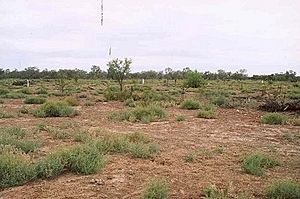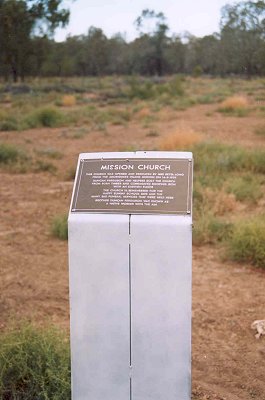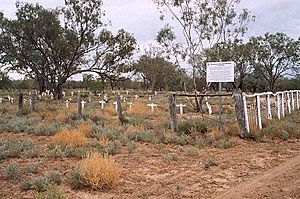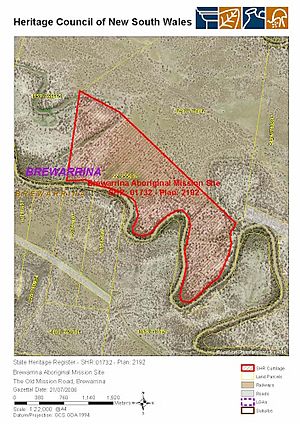Brewarrina Aboriginal Mission Site facts for kids
Quick facts for kids Brewarrina Aboriginal Mission Site |
|
|---|---|

Site of the mission
|
|
| Location | The Old Mission Road, Brewarrina, Brewarrina Shire, New South Wales, Australia |
| Built | 1880– |
| Official name: Brewarrina Aboriginal Mission Site; Barwon Mission; Brewarrina Mission; Brewarrina Aboriginal Station | |
| Type | state heritage (complex / group) |
| Designated | 21 July 2006 |
| Reference no. | 1732 |
| Type | Occupational site |
| Category | Aboriginal |
| Lua error in Module:Location_map at line 420: attempt to index field 'wikibase' (a nil value). | |
The Brewarrina Aboriginal Mission Site is a special place in New South Wales, Australia. It used to be a mission station and a cemetery for Aboriginal Australians. It was also known by other names like Barwon Mission or Brewarrina Aboriginal Station. The mission was built starting in 1880. Today, it is recognized as a heritage site, added to the New South Wales State Heritage Register in 2006.
Contents
History of the Mission
Why the Mission Started
In the late 1800s, many Aboriginal people lived around Brewarrina. The government group in charge of Aboriginal affairs, called the Aboriginal Protection Board, decided to create a special place for them. In 1885, they moved Aboriginal people to a reserve about 2 miles from town. Then, in 1886, a mission was set up on a larger piece of land, about 10 miles east of Brewarrina, next to the Barwon River.
Life at the Mission
Not everyone from Brewarrina moved to the new mission at first. In 1891, only 41 people lived there. Over time, especially in the 1920s and 1930s, many Aboriginal people from other areas like Tibooburra, Angledool, and Walgett were moved to Brewarrina Mission as other stations closed.
The Aboriginal Protection Board built houses for the people using materials like corrugated iron. Some houses were made of weatherboard. A church was also built from bush timber. It was used for Sunday school and funerals.
Buildings and Education
The mission had several buildings. These included a manager's house, a butcher's shop, a school, a church, and a small clinic. The school often didn't have trained teachers. Classes were taught by the mission manager or other staff. Mission schools usually only taught up to what we would call Grade three today.
There was also a dormitory for girls. Girls were often sent there to learn skills for domestic work. After their training, they were sent to work on farms or in homes across New South Wales.
Daily Life and Food
The mission had different managers over the years. The manager's house was called the "Big House." Sometimes, families were allowed to grow their own vegetables and fruits, like carrots, oranges, and peaches.
People at the mission received food supplies, called rations. Meat was given twice a week, and other supplies like sugar, tea, flour, and soap were given every two weeks. If the mission manager thought someone was causing trouble, their family's rations might be reduced. To get more food, many Aboriginal people would fish in the Barwon River or gather mussels.
Water was pumped from the Barwon River to the houses. Some houses had taps inside, but most had outside tubs for washing. The last burial at the mission cemetery happened in 1971.
Changes Over Time
The mission land was made much smaller in 1953, from 4,638 acres to just 638 acres. By 1965, only a few buildings remained, including small cottages, a school, and the manager's house.
What the Site Looks Like Today
Today, none of the original mission buildings are standing. The main feature is the cemetery, which is in a large grassy area. It has about 90 graves, with around 50 marked by wooden crosses or headstones. There are also two smaller burial sites nearby where ancestral remains were recently reburied.
Around the old mission area, you can find about 16 small signs. These signs explain what used to be in different spots. You can also see the concrete slab where a rehabilitation center once stood.
The local community wants to fix up the cemetery, as it needs repairs. They also hope to add more signs and create a driving path so visitors can easily see all the historical information. They would also like to clean up the area where the rehabilitation center was and possibly build a new shed on its old concrete base.
Why It's a Heritage Site
The Brewarrina Aboriginal Mission is very important because it was one of the oldest and longest-running mission communities in New South Wales. It was the first place formally set up by the Aboriginal Protection Board to house Aboriginal people. It operated from 1886 to 1966.
Many Aboriginal people from different areas were moved to Brewarrina Mission during this time. Many people who lived and died at the mission are buried in its cemetery. Even though the cemetery is no longer used for new burials, it is still very important to Aboriginal people.
The entire site, including the cemetery, is a significant place for many Aboriginal groups, like the Ngemba and Murrawarri tribes. They see it as a "place of belonging." The site holds deep cultural, spiritual, social, and historical value for many Aboriginal people across New South Wales.
Historical Importance
The Brewarrina Mission is important because it shows a key part of New South Wales's history. It was the first institution formally established by the Aboriginal Protection Board in 1886. Even though the buildings are gone, the cemetery remains, showing the long history of Aboriginal settlement here.
Connection to People
The site is important because it shows where many Aboriginal people lived. It was the oldest mission of its kind that was still managed in 1965. Starting in 1886, Aboriginal people were moved here from their homes, sometimes from far away places like Tibooburra and Walgett. The girls' dormitory was also important because it was where young girls were housed to learn domestic skills before being sent to work.
Community and Cultural Value
Brewarrina Mission has a strong connection for many Aboriginal people. It holds great historical, social, and cultural value. Even though many Aboriginal people were moved to the mission from their traditional lands, Brewarrina Mission remains a very important part of the community's identity and sense of place.
Showing a Way of Life
The Brewarrina Mission site helps us understand the way of life and customs of the many Aboriginal people who lived there between 1889 and 1966. As the site of the first Aboriginal Protection Board community, it shows important characteristics of these types of places. Although no buildings are left, the original cemetery is still there and is cared for by community members.




